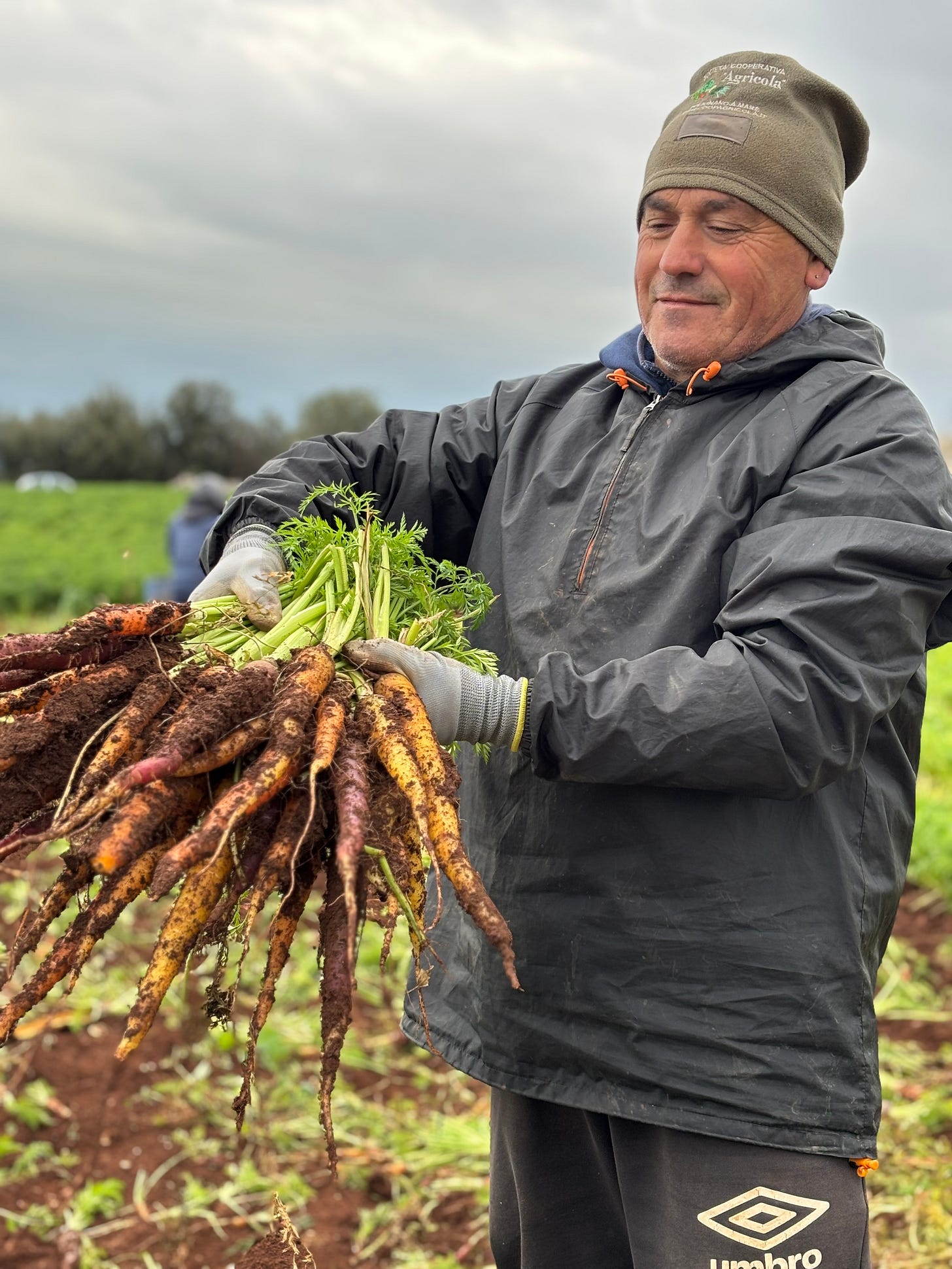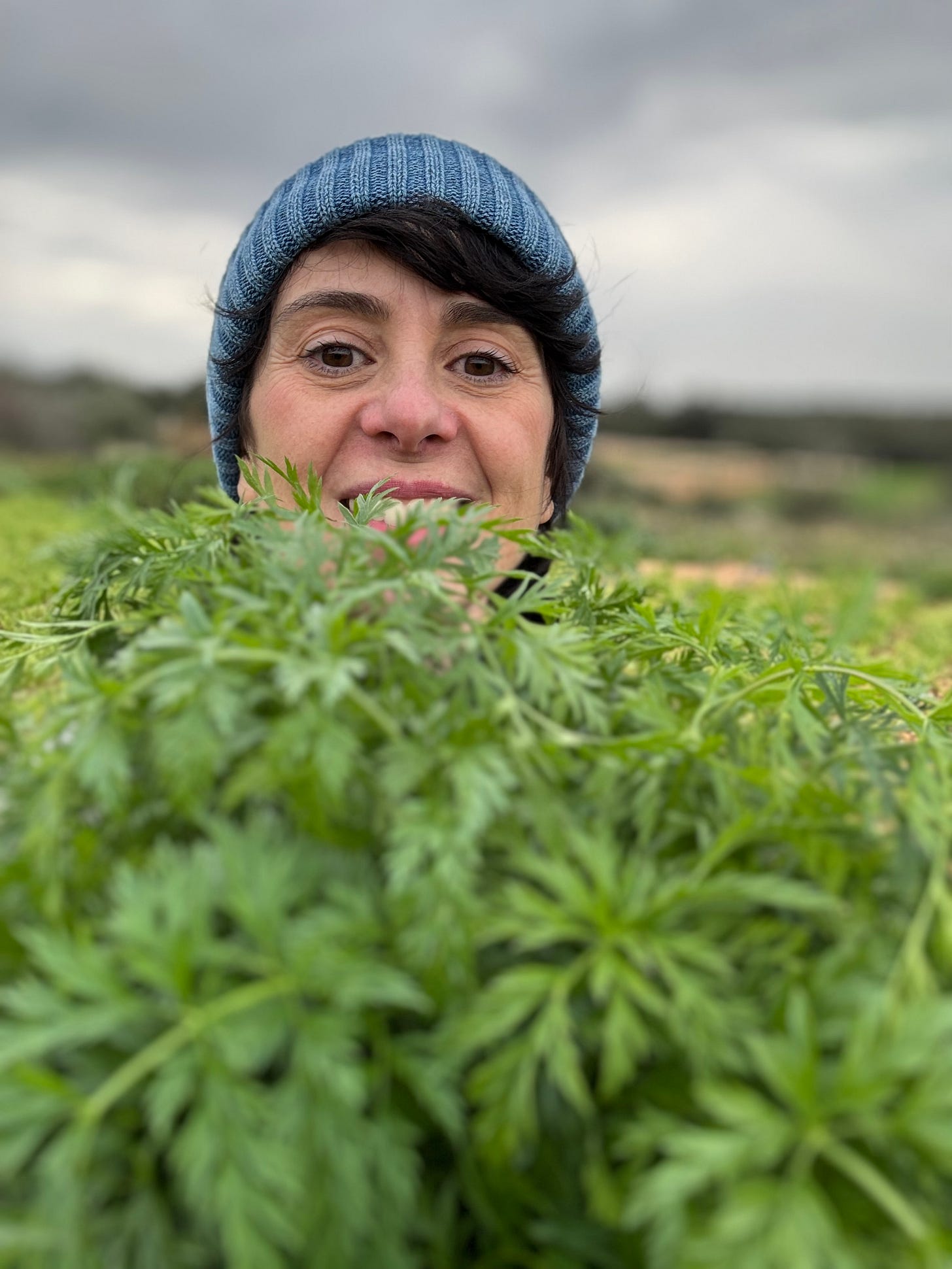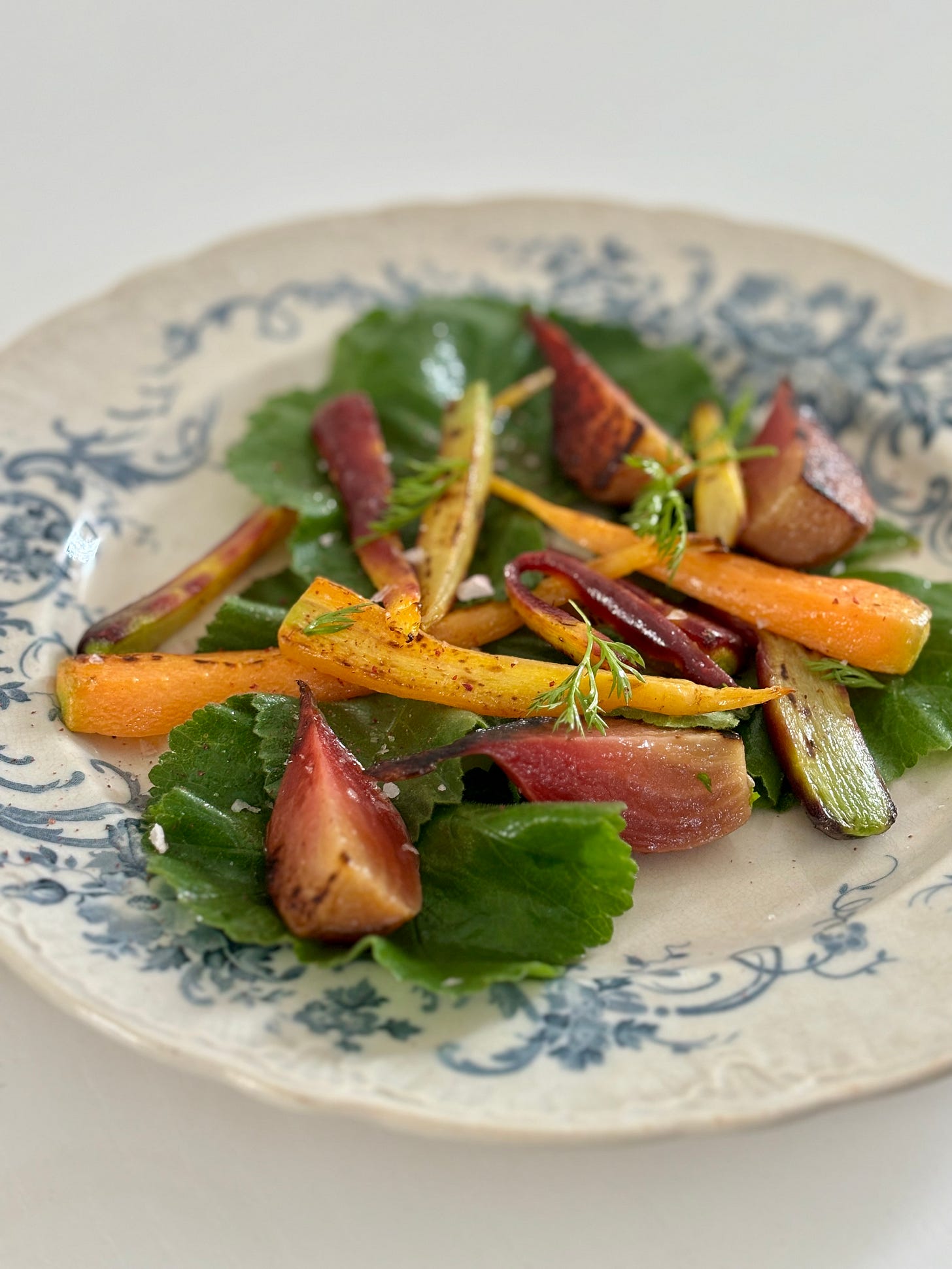Polignano in winter has a magnetic charm. As soon as the sun peeks through the clouds, I hear the sea calling: I slip on my sneakers, grab the leash of my little greyhound, Carla, and we head out for a walk along the coast. Sometimes we climb the cliffs that plunge into the sea, stepping over tide pools encrusted with sea salt and sun-baked algae. Other times, we stroll through the tiny fishing village of San Vito, a small hamlet of Polignano a Mare.
The little port glistens with bottle-green and ultramarine boats, streaked with blood-red paint; the Saracen tower rests its foundations on the beach, standing as a sentinel protecting the coastline; and the medieval abbey watches over the fields where wild brassicas brush against the roots of ancient fig trees, and bitter greens sprout in the shade of prickly pear paddles. Here, in this magical place made of sand, seawater, and tuff stone, the San Vito carrot is born.
Its origins are shrouded in mystery, but Modesto Guglielmi of Mestagnaz — one of the guardian farmers who helped rediscover and protect this ancient local variety — told me about a possible connection to Turkey. The port of San Vito, after all, was a crossroads of cultures and trade for centuries, and the seeds of this carrot may have been exchanged in barter between a passing Turkish boat and the monks of the abbey. Seed swapping, and the propagation of plants across nations and borders, is an ancient practice passed down through generations of farmers worldwide. In this case, even though there is no exact date or historical evidence to support the theory, it’s fascinating to imagine these silent exchanges giving life to such a unique product.
San Vito carrots are not the usual standardized orange carrots we're used to. Here, the land gives birth to multicolored vegetables: from deep violet to lemon yellow, with shades of pale, clementine-like orange in between. Some carrots even carry all three hues in one root, and these are said to be the most flavorful, with a complex, layered taste.
The purple color comes from anthocyanins, compounds that add a fruity, slightly spicy, and briny note. The yellow and orange carrots, on the other hand, are sweeter, with a balsamic aroma that recalls the gentle resin of pine. Every bite carries a hint of the sea's saltiness and the fragrances of Mediterranean scrub, bursting with freshness and minerality.
San Vito carrots require specific conditions to reach their full potential. They grow from November to April, thriving in cool temperatures and sandy soils, gently kissed by brackish, cold water that nourishes their roots deep underground.
Their propagation method is just as fascinating: the best carrots are selected, chopped into pieces, and replanted in the soil. From a yellow carrot, a purple or orange one might grow, making every harvest a surprise. However, when transplanted into warmer soils, these carrots lose their crisp texture and become more fibrous, proving how deeply their flavor is tied to the land they grow in.
On one of my walks, I visited the farmers who tend to this delicate crop, and they shared the careful technique required for harvesting. San Vito carrots are harvested meticulously, entirely by hand. The root grows deep into the earth, and if you try to pull them up by their green tops, they break easily. So, a pitchfork is used to gently loosen the soil around them before each carrot is carefully pulled out by hand. Broken carrots are worth less than whole ones—not just in the market but also out of respect for this fragile, precious product.
In the fields, the carrots are sorted and then gently washed to remove the sandy soil, revealing their glossy, multicolored skins. They are truly a feast for the eyes, and they inspired two recipes I’d love to share with you in this newsletter.
Let’s be clear—you can absolutely make these recipes with local carrots from your nearest farmers' market. But if you’re lucky enough to get your hands on San Vito carrots, your dish will carry a special, unmistakable flavor.
San Vito carrot and blood orange risotto
Serves 2
160 g (5.6 oz) Carnaroli rice
2 saffron threads
1 liter (4 ¼ cups) vegetable stock
2 medium Polignano carrots, boiled and peeled (yellow or orange)
1 purple carrot for garnish
Juice of ½ blood orange
1 teaspoon toasted almonds
Carrot greens (optional)
4 tablespoons grated Parmigiano Reggiano
Light, fruity extra virgin olive oil
Toast the rice in a dry pan over medium heat until it’s warm and releases a delicate, nutty aroma. Add two ladles of hot stock, the saffron threads, and cook over low heat, stirring as little as possible.Meanwhile, make a purée by blending the yellow and orange carrots with the blood orange juice and a pinch of salt. Slowly drizzle in about two tablespoons of olive oil until creamy. Set aside.
Continue cooking the risotto, adding stock as needed to keep it from sticking, allowing each addition to absorb before adding more. In the last five minutes, stir in the carrot and orange purée, letting the flavors meld until the risotto is ready.
Turn off the heat and stir in the Parmigiano Reggiano and a tablespoon of extra virgin olive oil to finish. Serve with a sprinkle of chopped toasted almonds, finely chopped carrot greens, and a few slices of purple carrot for a colorful, crunchy finish.
The second recipe is a warm carrot and beet salad, dressed with a lemon vinaigrette and served with fresh mallow leaves. I found these growing wild in the field, right next to the carrots, and couldn’t resist picking them. If mallow is hard to find, fresh spinach leaves make a lovely substitute.
Warm San Vito carrot, roasted beet, and mallow salad
Serves 2
4 San Vito carrots, boiled
3 small beets, boiled
A dozen fresh mallow leaves (or substitute with fresh spinach)
Juice of ½ lemon
Extra virgin olive oil
Salt
Freshly ground black pepper
Toasted pumpkin seeds
Cut the carrots into thick sticks and quarter the beets. Arrange the vegetables on a baking sheet, drizzle with olive oil, gently toss, and roast in a convection oven at 180°C (350°F) for 10 minutes.
While the vegetables roast, prepare a vinaigrette by mixing the lemon juice with two tablespoons of extra virgin olive oil, a pinch of salt, and a grind of black pepper.
Once the vegetables are ready, remove them from the oven and let cool slightly.
Toss the mallow leaves with the vinaigrette, then assemble the salad by adding the roasted carrots and beets. Finish with a sprinkle of toasted pumpkin seeds and serve.
This salad also makes a hearty main dish when paired with a creamy spread of cooked legumes — like chickpeas, cannellini beans, or red lentils — blended into a rustic hummus with a drizzle of olive oil and a clove of garlic.











Thank you Flavia for the lovely presentation of the Polignano carrots! You will eat them directly from the photos! I’ll try all the recipes with the Swedish carrots, I’ll do! Love😘❤️
I so would love to try them!